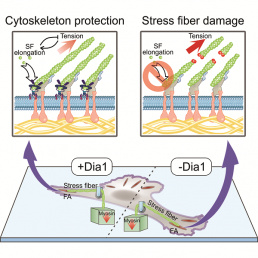When you’re dancing, running or even walking, fibroblast cells stretch and adapt to all your vigorous movements. What allows these dynamic cells in our bodies to keep their shape and position without being torn apart? Fernando Valencia in Sergey Plotnikov’s lab at Cell & Systems Biology has determined that cells respond to internal forces by activating Dia1 proteins at force-bearing focal adhesions, which dampens tension on the actin cytoskeleton and helps the cell control its shape and maintain its integrity.
Cells under external tension experience internal forces through attachment points on their surface called focal adhesions. Actin and myosin proteins are components of the cytoskeleton that form dynamic stress fibers at the focal adhesions. Plotnikov wondered if there was a protein that would regulate recruitment of cytoskeletal components to lengthen or shorten these fibers.
Valencia was fascinated to work in Plotnikov’s lab since physical forces are such a fundamental property in science. As a new student, he and Plotnikov decided to focus on formin proteins, which were known to be found in proximity to actin. Through chemical and genetic tests, they found that disrupting expression of the mouse formin protein mDia1 greatly reduced the rate of actin incorporation into stress fibers.
In cells depleted of mDia1, Valencia observed that the stress fibers suffer mechanical damage. Under normal conditions, stress fiber repair would be mediated by the zyxin protein, but under reduced mDia1 levels, the effectiveness of this repair system is also degraded. Thus mDia1 has a pivotal role in safeguarding stress fibers against mechanical damage.
By combining live-cell imaging with mathematical modelling, Valencia showed that actin polymerization at focal adhesions exhibits pulsatile dynamics. They conclude that activity of mDia1 dampens the mechanical tension on the stress fibers through spikes of mDia1 activity triggered by contractile forces.
This work is published in the journal Developmental Cell as “Force-dependent activation of actin elongation factor mDia1 protects the cytoskeleton from mechanical damage and promotes stress fiber repair”

